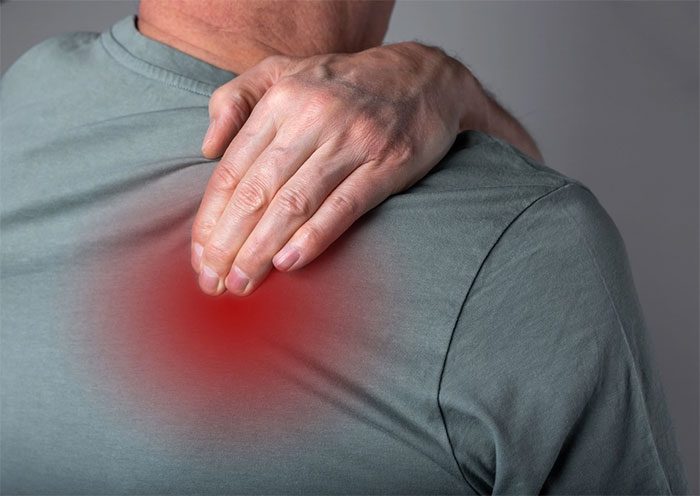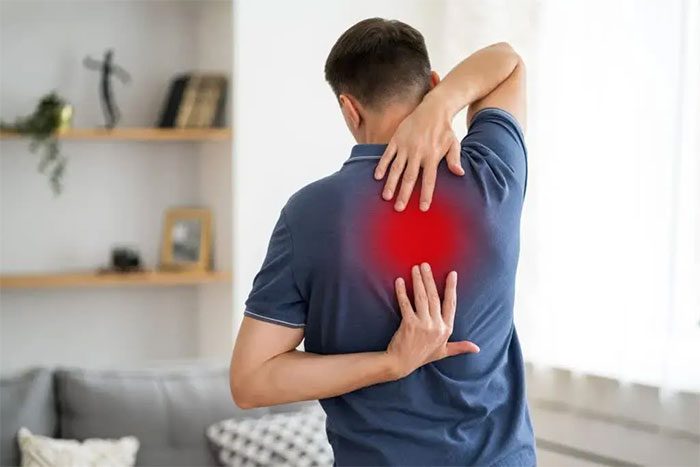There are numerous underlying causes for the burning sensation in the upper back beyond injury.
Important Information About Burning Sensation in the Upper Back
Various back conditions can lead to a burning sensation in the upper back. Depending on the cause, symptoms, and related factors, treatment methods may vary.
Note that some conditions that cause burning in the upper back require emergency medical attention, so do not be complacent.
1. What is the burning sensation in the upper back?
Unlike dull pain, sharp pain, or stabbing pain, a burning sensation is a distinct type of pain that is easily recognizable. This type of pain can also occur in other parts of the body, such as the hands, feet, and upper back.
Thoracic Disc Herniation
This condition can occur in individuals who have experienced trauma from lifting, twisting, or turning their neck, causing the disc to slip out of its original position. Thoracic disc herniation can result in sharp or burning pain in the upper back.
Sunburn
Excessive exposure to ultraviolet (UV) rays from the sun can cause sunburn, leading to burns that feel hot and painful. The upper back, which is often unprotected, is particularly vulnerable to sunburn when exposed to excessive UV rays. Symptoms of sunburn typically begin about 4 hours after sun exposure.
The pain from sunburn can worsen within 6 to 48 hours if not treated appropriately.

Upper back pain is a common issue caused by various factors. (Image: Internet).
Spinal Tumor
A tumor in the spine can cause nerve root pain, resulting in sharp, burning sensations in areas such as the back, which may radiate to the hands, arms, and legs. The intensity of the pain may vary with movement.
Heartburn
Frequent heartburn can sometimes cause a burning sensation in the upper back (in severe cases), in the chest, or in the throat due to stomach acid flowing back into the esophagus.
Fibromyalgia
Fibromyalgia not only causes burning in the upper back but can also occur in any part of the body accompanied by fatigue, joint pain, muscle aches, tendon pain, and ligament pain. The pain from fibromyalgia may start in the neck, shoulders, and around the upper back.
Over time, symptoms in other areas may appear with varying degrees, including a burning sensation akin to being burned.
Skin Infections
Common skin infections, such as cellulitis, can make certain areas of the body more sensitive and feel hotter. This bacterial infection is often found in the feet and lower legs but can also affect other areas, including the upper back.

Depending on the case, upper back pain causing burning or tingling is treated differently. (Image: Internet)
Muscle Strain
Injuries to the back region or overuse of back muscles can also lead to a burning or tingling sensation in the upper back, between the shoulder blades, or on either side of the spine.
Sometimes muscle strain can extend to the chest, and symptoms may worsen with repeated movements.
Scoliosis
Scoliosis is another reason for a burning and aching sensation in the upper back. There are many causes of spinal misalignment, including poor posture, sleeping in the wrong position, injuries from accidents, and repetitive habits.
Pain from scoliosis is typically located between the shoulder blades or in the neck.
Arthritis Conditions
Arthritis conditions such as rheumatoid arthritis, osteoarthritis, lupus, and others affect joints, tendons, muscles, and bones throughout the body, including the upper back. Depending on the inflammation, patients may experience sharp, burning pain on the left or right side of the upper back or between the shoulder blades.
Bone Spurs
Bone spurs forming on the spine can compress nerves, resulting in burning sensations, paralysis, or weakness in the upper back, neck, and thoracic spine.

See a doctor early if upper back pain interferes with daily activities. (Image: Internet).
Spinal Stenosis
Spinal stenosis is a condition where the space within the spinal canal narrows, putting pressure on the nerve roots and spinal cord. This can lead to upper back pain, neck pain, and may radiate to the chest.
2. Treatment Methods for Burning Sensation in the Upper Back
Treatment for the burning sensation in the upper back depends on the underlying cause. Doctors may address some causes of upper back pain with over-the-counter pain relievers, anti-inflammatory medications, muscle relaxants, and treatments targeting the nervous system that processes pain, prescription pain medications, or physical therapy.
If the burning pain in the upper back is due to an infection, the doctor may prescribe antibiotics for treatment.
If the aforementioned treatments do not alleviate pain and improve the condition, the doctor may recommend surgery if you have a thoracic disc herniation, such as removing part of the disc that is pressing on the nerve roots or spinal cord.

Gentle movement may help relieve back pain. (Image: Internet).
3. Home Remedies for Upper Back Pain Relief
Here are some home remedies for relieving upper back pain:
Heat or Cold Compress
For acute pain from injuries or muscle strains, cold therapy can help reduce inflammation and pain. You can apply a towel to your back and neck for up to 20 minutes at a time. If the pain is chronic, warm compresses may be more effective due to their ability to soothe and relax muscles, as well as improve blood circulation. The duration for heat application should not exceed 15 to 20 minutes at a time.
Adequate Sleep
Lack of sleep increases stress levels and can exacerbate upper back pain. Aim for 7 to 9 hours of sleep each night in a comfortable and quiet sleeping environment.
Exercise
Engaging in gentle physical activities can improve blood circulation, strengthen the upper back muscles, and reduce inflammation in cases of mild to moderate pain. If you experience pain while exercising or have difficulty breathing, stop immediately and consult a doctor.
4. When Should You See a Doctor for Upper Back Pain?
Some upper back pain may resolve on its own after home treatment and over-the-counter medications within a few days to weeks.
However, if the burning sensation in the upper back shows no signs of improvement or worsens, you may need diagnostic imaging tests such as X-rays or MRIs to identify the underlying cause of the pain, allowing for an appropriate treatment plan.


















































